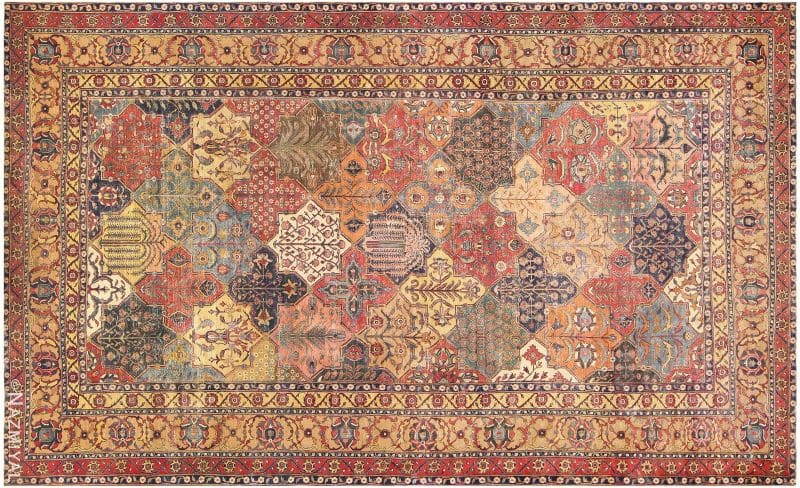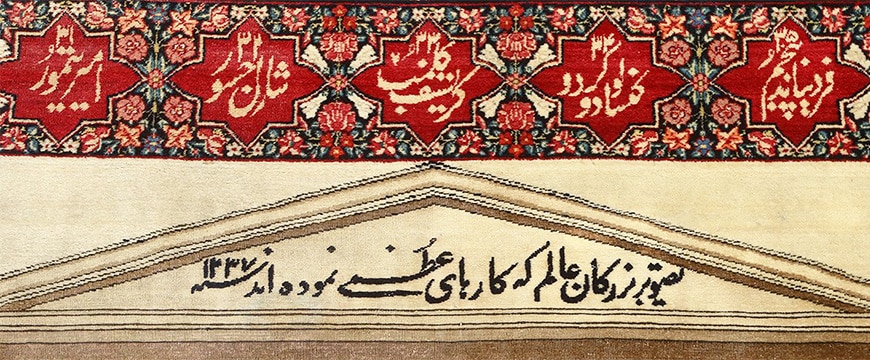Islamic Art And Islamic Carpets in History
Throughout history, certain events left their mark on the development of the carpet industry and design. The spread of Islam and the advent of Islamic art and the Islamic carpets is one of those events that contributed to the beautiful patterns and colors that we enjoy today. Persian carpet design in particular was greatly influenced by Islamic traditions.
What Is Islamic Art?
Islamic art refers to the artistic traditions and styles that have emerged from the Islamic world, primarily influenced by the teachings of Islam. It encompasses a wide range of artistic forms including architecture, calligraphy, painting, ceramics, textiles, metalwork, and more. Islamic art is not limited to a specific geographical region or time period but has developed and evolved over centuries in various parts of the world where Islam has been practiced.
What are the roots of Islamic art?
Islamic art has deep roots that can be traced back to the early days of Islam in the 7th century. The roots of Islamic art are influenced by a combination of cultural, religious, and geographical factors.
Here are some key aspects of Islamic art:
- Islamic Calligraphy: The Quran, the holy book of Islam, played a significant role in shaping Islamic art. Calligraphy became a prominent form of artistic expression, with skilled calligraphers creating beautiful scripts of Quranic verses.
- Geometry and Patterns: Islamic art is known for its intricate geometric patterns and designs. This is influenced by Islamic beliefs that discourage the depiction of living beings. Geometric shapes and patterns are often used in architecture, ceramics, and textiles.
- Arabesque and Floral Designs: Arabesque refers to intricate patterns of intertwining foliage, flowers, and geometric shapes. This type of design is commonly found in Islamic architecture, especially in mosques and palaces.
- Islamic Architecture: Islamic architecture is characterized by features such as domes, arches, and minarets. Notable examples include the Dome of the Rock in Jerusalem and the Alhambra in Spain. The use of calligraphy, geometric patterns, and arabesque is also evident in architectural elements.
- Mosaics and Tilework: Mosaic art and tilework are common in Islamic art, adorning buildings, walls, and floors. These mosaics often incorporate geometric patterns and vibrant colors.
- Illuminated Manuscripts: Manuscripts, including Quranic manuscripts and other religious texts, were often illuminated with intricate designs and illustrations. This form of art was prevalent in the Islamic world.
- Influence of Pre-Islamic Cultures: Islamic art also absorbed elements from pre-Islamic cultures in the regions where Islam spread. This includes influences from Byzantine, Persian, and Central Asian traditions.
- Cultural Exchange: Islamic art has been shaped by cultural exchanges through trade, conquests, and interactions with various civilizations. This led to a rich diversity in artistic styles across the Islamic world.
Overall, the roots of Islamic art are intertwined with the religious, cultural, and historical developments of the Islamic civilization, resulting in a distinctive and diverse artistic tradition.
As noted above, Islamic art is deeply rooted in the Islamic faith and its principles. It is characterized by the prohibition of depicting human figures in religious contexts, leading to a strong emphasis on geometric patterns, arabesques, and intricate floral designs. These motifs are often used to decorate architectural elements, manuscripts, and other artistic objects.
One of the most prominent forms of Islamic art is Islamic architecture, seen in the construction of mosques, palaces, and tombs. Islamic architecture is known for its distinctive features such as domes, minarets, and intricate tile work. Examples of renowned Islamic architectural wonders include the Alhambra in Spain, the Taj Mahal in India, and the Great Mosque of Cordoba in Spain.
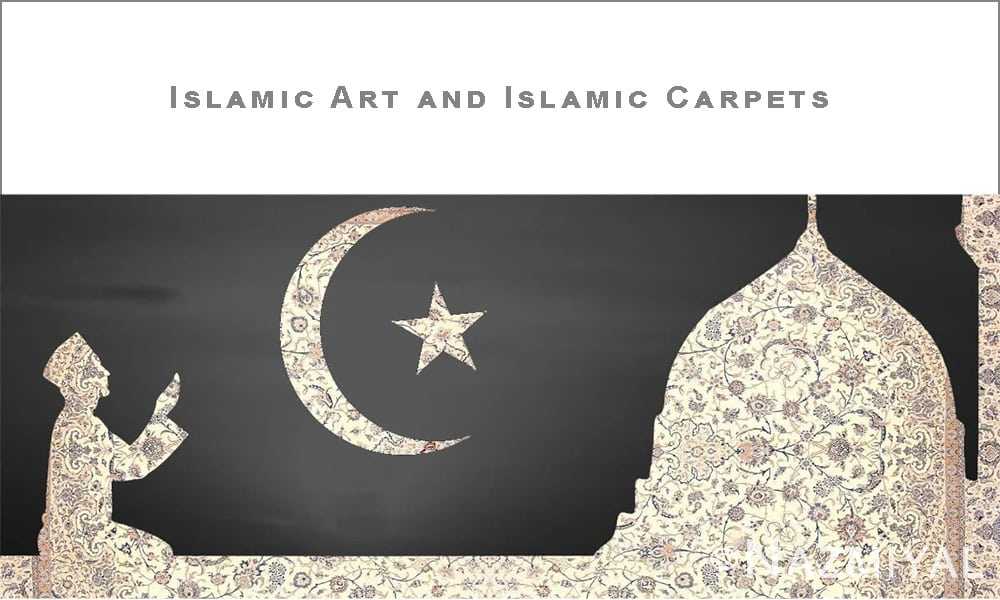
Islamic Art and Islamic Carpets
Calligraphy is another significant aspect of Islamic art. The Arabic script, used to write the Quran, is highly regarded and considered a sacred art form. Islamic calligraphy can be found adorning walls, manuscripts, ceramics, and textiles. The calligraphic compositions often include verses from the Quran or other religious texts.
Islamic art also demonstrates a rich tradition of manuscript illumination, miniature painting, and textile design. Manuscripts are adorned with intricate patterns, colorful illustrations, and gold leaf detailing. Miniature paintings often depict religious scenes, courtly life, and literary works. Textiles, such as carpets and textiles woven with intricate designs, are highly prized for their craftsmanship and beauty.
Throughout history, Islamic art has been influenced by various cultures and artistic traditions, including Persian, Byzantine, Central Asian, and Indian. This cross-cultural exchange has contributed to the diversity and richness of Islamic art.
Overall, Islamic art is a vibrant and diverse artistic tradition that reflects the cultural and religious values of the Islamic world. It combines intricate geometric patterns, calligraphy, and a wide range of artistic forms to create visually stunning and spiritually significant works of art.
The Origins Of Islam And The Islamic World
Islam began in the Arabian Peninsula, and over several hundreds of years, it spread throughout Spain, the Byzantine Empire, the Sasanian Empire and throughout Asia. “The Islamic world” refers to countries where the rulers and people adhere to the practice of Islam. Although there is no specific criterion for inclusion, this world has expanded and contracted throughout history.
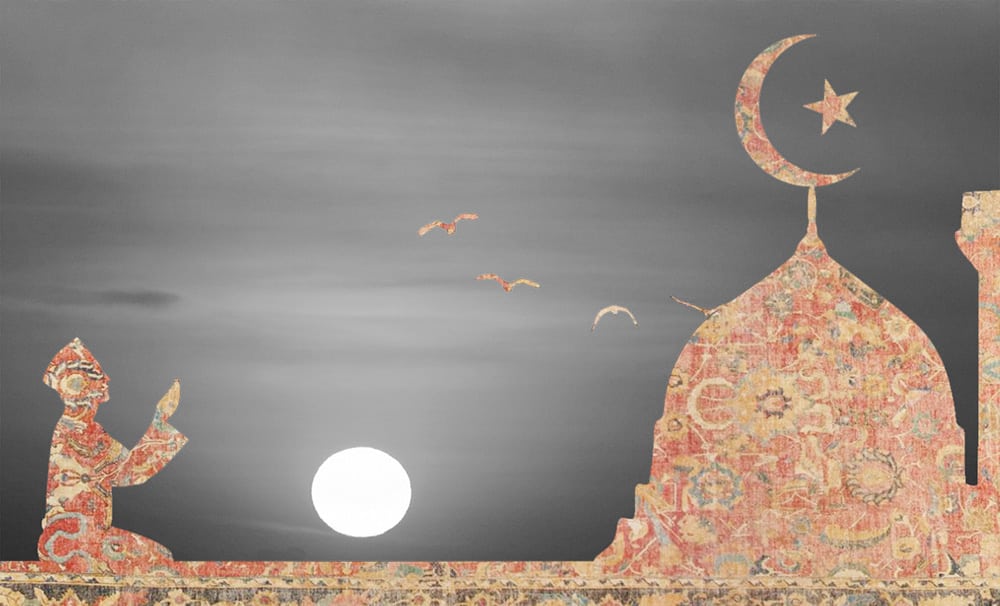
Antique Islamic Carpets
As Islam spread into new areas, it meant that local culture and political changes were impacted. This naturally includes almost every area of society and life including the arts.
History Of Islamic Art and Rugs
What are some of the most iconic works of Islamic art?
Islamic art has produced numerous iconic works that span a wide range of mediums, including architecture, calligraphy, manuscript illumination, ceramics, and textiles.
Here are some of the most iconic works of Islamic art:
- Dome of the Rock (Jerusalem): One of the earliest and most significant examples of Islamic architecture, the Dome of the Rock features a stunning golden dome and intricate tilework. It is located on the Temple Mount in Jerusalem and holds great religious significance.
- Alhambra (Granada, Spain): The Alhambra is a palace and fortress complex known for its exquisite Islamic architecture. It features stunning tilework, intricate stucco carvings, and beautifully landscaped gardens.
- Great Mosque of Cordoba (Spain): The Great Mosque of Cordoba is an architectural masterpiece, known for its horseshoe arches, intricate tilework, and a distinctive mihrab. The mosque was later converted into a cathedral.
- Blue Mosque (Istanbul, Turkey): Officially known as the Sultan Ahmed Mosque, the Blue Mosque is an iconic Ottoman structure. It is famous for its six minarets, blue tiles that adorn the interior, and a grand courtyard.
- Topkapi Palace (Istanbul, Turkey): The Topkapi Palace served as the main residence of Ottoman sultans for centuries. It features opulent rooms, courtyards, and a rich collection of Islamic art, including manuscripts and ceramics.
- The Book of Kells (Ireland): While not directly from the Islamic world, the Book of Kells is an illuminated manuscript that showcases the influence of Islamic geometric patterns on medieval Christian art in Ireland.
- Ardebil Carpet (Victoria and Albert Museum, London): This Persian carpet from the 16th century is renowned for its intricate design and fine craftsmanship. It is one of the world’s oldest surviving carpets.
- Tilework of Isfahan (Iran): Isfahan is known for its beautiful tilework, seen in structures like the Sheikh Lotfollah Mosque. The city’s bridges, palaces, and mosques feature stunning examples of Persian tilework.
- Timurid Manuscripts: Illustrated manuscripts from the Timurid period, such as the “Shahnameh of Shah Tahmasp,” showcase exquisite Persian miniature painting and calligraphy.
- Casket of Cordoba (Museo Nazionale del Bargello, Florence): This medieval Islamic ivory casket from Andalusia features intricate carvings and inscriptions, representing the skilled craftsmanship of the time.
These examples highlight the diversity and richness of Islamic art across different regions and time periods. Islamic art is characterized by a combination of geometric patterns, calligraphy, and a deep connection to cultural, religious, and historical contexts.
Islamic Art as a Way of Life
Looking at Islamic art, art enthusiasts will spot a common thread with four basic components: calligraphy, vegetative patterns, figurative representation and geometric patterns. When individuals look at art of the Islamic faith, they will see it as more of a way of a life. Nevertheless, it’d be a great mistake for someone to mistake Islamic art as doing nothing more than giving a display of the Islamic faith because it has wonderful diversity to it, and a personality all of its own. Changes to the themes have changed over time.
Distinguished Muslim Art
When most people think of the Middle East, they imagine some of the cornerstone pieces of Islamic art. For example, the Muslim world has a characterization through its architecture, and the art in the land often came from many of its patrons. Muslim art became so distinguished that it, in fact, became a culture and language of its own. People will spot many new and unique artistic flavors reflected in the art and the architecture of the Muslim world.
How The Islamic Arts Had Influences
The influences on Muslim art came from artists who worked under the Sasanian and the Byzantine empire. During this period, a new era of art emerged as the work from some of the indigenous people of the region added their own unique style to the Muslim patrons. Some of the decorative themes with Islamic art can be identified in some of the earlier styles and techniques for blending the classics and adding the Iranian decorative theme. Many of the religious monuments had Islamic artists who worked on them. For example, some of them were made during the Umayyad patronage, and it has a distinguished Islamic flavor. One example of Islamic architecture shows itself in Jerusalem at an Islamic shrine called, “Dome of the Rock.”
Umayyad Caliphate
The Umayyads were responsible for borrowing the architectural techniques from the Byzantines. The Dome of the Rock is the oldest surviving Islamic building built in 1023 after it had collapsed. The Umayyads introduced many innovations to architecture, but during this time, their artistic flare became huge with the buildings they were constructing.
Punctuated by the Different Dynasties
Much of the art follows the precepts of Islamic history. Art experts divided the art based on the various dynasties. Some of the common distinctions include:
- Ottomans
- Safavids
- Mughals
One of the wonderful things related to Islamic art comes from the fact that individuals have many different regional and national styles that they can see. A great deal of diversity has been added to the art, and people can look at it over a period of time to see how it evolved.
Why are rugs important in Islamic culture?
Rugs hold significant cultural, artistic, and practical importance in Islamic culture.
Here are several reasons why rugs are important in Islamic culture:
- Prayer Space: Rugs play a crucial role in the Islamic practice of daily prayers (Salah). Muslims use a prayer rug to establish a clean and dedicated space for prayer. The rug provides a clean and comfortable surface for prostration and other prayer postures.
- Symbolism and Spirituality: Islamic rugs often feature geometric patterns, arabesques, and calligraphy with religious significance. These symbols can enhance the spiritual atmosphere of a space and serve as a reminder of Islamic teachings. Arabic calligraphy, including verses from the Quran, is sometimes incorporated into rug designs, adding a sacred dimension.
- Cultural Identity: Rugs are integral to the cultural identity of many Islamic societies. Different regions, such as Iran, Turkey, Central Asia, and North Africa, have distinct rug-making traditions with unique patterns, colors, and motifs. Rugs can reflect the artistic heritage and cultural identity of a specific Islamic community.
- Artistic Expression: Islamic art, including rug-making, is known for its intricate geometric patterns, arabesques, and vibrant colors. Rugs are considered a form of artistic expression, with skilled artisans creating unique designs that may draw inspiration from Islamic architecture, calligraphy, and traditional motifs.
- Craftsmanship and Handmade Tradition: Many Islamic rugs are handmade using traditional weaving techniques passed down through generations. The craftsmanship involved in creating these rugs is highly valued, and each rug may represent a labor-intensive process of artistic creation.
- Social and Economic Importance: Rug-making is often a significant economic activity in Islamic societies. Artisans and weavers contribute to local economies, and the production of rugs supports livelihoods in many regions. The sale and trade of rugs also contribute to international commerce.
- Hospitality and Home Decor: Rugs are commonly used in homes and serve a practical purpose in providing warmth and comfort. They are also an integral part of hospitality in many Islamic cultures. Guests are often welcomed into homes with the gesture of offering a clean and comfortable rug to sit on.
- Tradition and Heritage: Rugs are a part of the rich cultural heritage of Islamic societies. The traditional methods of rug-making, including dyeing, weaving, and knotting, are passed down through generations, preserving cultural traditions and skills.
In summary, rugs in Islamic culture serve multifaceted roles, encompassing religious practices, artistic expression, cultural identity, economic contributions, and the warmth of hospitality. They are woven into the fabric of daily life and hold both practical and symbolic significance within the Islamic tradition.
What would be considered an “Islamic area rug”?
An “Islamic area rug” typically refers to a rug that is designed with patterns, motifs, and elements inspired by Islamic art and culture. These rugs often incorporate traditional Islamic geometric patterns, arabesques, and other decorative elements.
Here are some characteristics that might be associated with Islamic area rugs:
- Geometric Patterns: Islamic art is known for its intricate geometric patterns, and these are often featured prominently in Islamic area rugs. Common geometric shapes include stars, polygons, and interlacing lines.
- Arabesque Designs: Arabesques are intricate designs featuring intertwining foliage, flowers, and vines. Islamic area rugs may include arabesque motifs as part of their overall design.
- Calligraphic Elements: Some Islamic area rugs may incorporate Arabic calligraphy, often featuring verses from the Quran or other religious texts. Calligraphy can add a spiritual and artistic dimension to the rug.
- Traditional Color Palette: Islamic art often uses a vibrant and rich color palette. Islamic area rugs may feature colors such as deep blues, reds, greens, and gold, reflecting the traditional hues found in Islamic art.
- Cultural and Regional Influences: The design of Islamic area rugs can also be influenced by the specific cultural and regional traditions of the area they originate from. For example, rugs from Iran (Persian rugs) may have distinct patterns compared to those from Turkey or Central Asia.
- Handmade Craftsmanship: Many Islamic area rugs are crafted by hand, using traditional weaving techniques. Handwoven rugs often have a level of detail and craftsmanship that adds to their artistic value.
- Symbolism: Some Islamic area rugs may incorporate symbols and motifs that hold cultural or religious significance within the Islamic tradition. These symbols can vary based on the specific cultural context.
The term “Islamic area rug” is broad, and the design and characteristics can vary based on regional influences, cultural nuances, and individual artistic interpretations. Additionally, not all rugs from Islamic regions or with Islamic-inspired designs are necessarily classified as “Islamic area rugs,” as the term may be used more broadly to describe rugs with motifs inspired by Islamic art and culture.
Islamic Art in Antique Rugs: The most iconic Islamic art form and cultural tradition
Carpet weaving is the most iconic Islamic art form to come out of Islamic societies. This extraordinary tradition is most famous for producing the ‘pile carpet’ also known as the ‘oriental carpet.’ And so, predominantly you will find the most sophisticated Islamic art in antique rugs.
In the late 16th century, Shah Abbas made an economical plan that set the carpet weaving industry on fire. He did this by making trade treaties with Spain, England, and France. As a result, carpet weaving transformed from the hands of peasants to that of prestigious artists. It was soon a national industry.
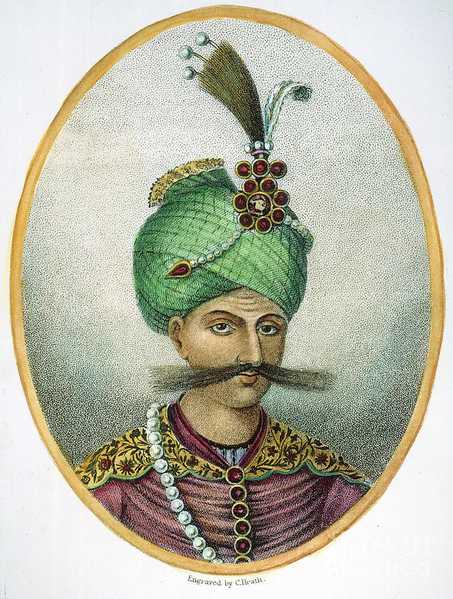
Shah Abbas, a historical force behind Islamic art and carpets.
Within Islamic societies, the finest pieces were collected in royal households, but they became acquired by royalty outside of Islam as well. By the early 17th century, Islamic rugs were being generated more than ever before and becoming a status symbol throughout European high society households. These exquisite Islamic art pieces were too precious for the floor, so they were commonly used to decorate the walls or cover furniture.
As for the earliest Islamic carpets, most cease to exist. Of those that survived the ages, early scholars had to depend on Italian and Flemish paintings, particularly Renaissance paintings, to determine their birthdays. These historical paintings became a major source of information on early Islamic carpet weaving.

The Saithwaite Family by Francis Wheatley, Circa 1785
Moving forward, rugs from the 17th century were identified from the clues the actual rug provided, such as its type of dies, style, and design. Origin was often determined by the knot style. For instance, Persian carpets were typically made with an asymmetrical knot while Turkish carpets were made with the opposite.
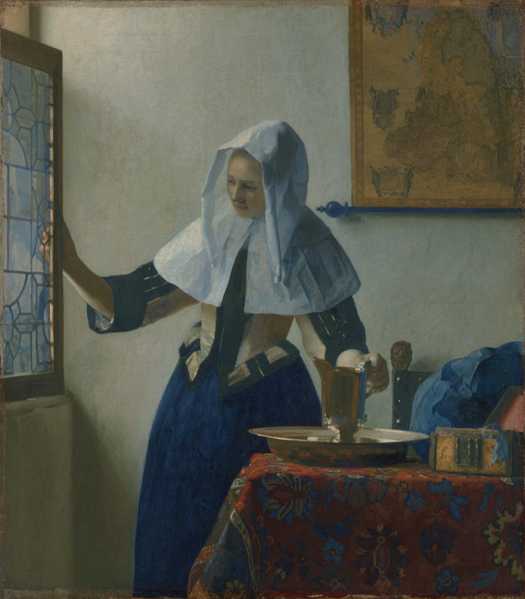
Young Woman with a Water Pitcher by Johannes Vermeer, Circa 1660-67
In conclusion, antique rugs are a monumental part of Islamic Art History. They serve as expressive, decorative representations of Islamic history and a major entity in the world’s extraordinary history of art as a whole.
Islamic Carpets: From Cottage Industry to Fine Art
Throughout the Islamic world, women had been weaving carpets for thousands of years. They passed on their techniques and designs from one generation to the next. The introduction of Islam allowed the utilitarian practice of carpet weaving to elevate to a fine art form in many areas of the world. The Islamic carpets were no longer only functional pieces of furniture. These magnificent objects were elevated into a symbol of status and wealth for their owners and were made for the royal courts of the Islamic world.
Many of the traditional rug designs were still being produced in rural areas, but the introduction of Islam meant new patterns and the standardization of production methods. This was necessary to produce the exquisite court rugs that found their way into mosques, reception halls, and audience chambers. These antique rugs became a new class of artwork that catered to the wishes and needs of the ruling class.
New Islamic Carpet Patterns Under Islamic Rule
Changes in carpet patterns reflected changes in the artwork found throughout the Islamic world. For instance, Oriental rugs began to mimic the tiled geometric patterns that were found in architecture. Carpets began to be produced with a repeated motif in an all-over pattern throughout the entire field. Another style that made its way into carpets was the “saz” style, which used flowers with stylized leaves that gracefully curved throughout the design.
The carpets began to develop into a garden of colors and shapes including a wide range of floral designs such as roses, carnations, hyacinths, tulips, lotus flowers, trees, and fruits. Secular art continued to be produced, but new forms of religious art were added to the traditional local mixture of styles. This expanded the design possibilities in both the production centers of cities and villages.
Inclusion of Calligraphy in Islamic Carpets
With the introduction of Islam, another element that appeared was the introduction of calligraphy into the carpets. Calligraphy is a stylized rendition of phrases and words in a way that makes them into a beautiful piece of artwork. Sometimes this calligraphy may just look like it is Arabic writing when in fact, it is purely decorative.

Kufic Border Of Antique Shirvan Rug
The calligraphy that actually has linguistic meaning, may include words or phrases from the Quran or perhaps a piece of poetry. Early forms of this calligraphy began to appear in the 1450’s. Words and phrases in stylized Arabic writing called “Kufic” were placed in the borders of the carpets. These would eventually be replaced by floral and saz motifs.
The inclusion of calligraphy and other highly detailed motifs required the production of Islamic carpets that were finely woven and had a high knot density. The introduction of these elements meant improvements in the quality and processes for creating these fine carpets. It also meant that rug weavers would need the ability to follow a given pattern, rather than reciting the patterns from memory. This shift represents the formalization of the artistic process that is used to create the carpets. Schools and weaving workshops were developed to teach design and weaving for the production of these magnificently fine Court carpets.
The Introduction Of The Islamic Prayer Rugs
One of the most important introductions of designs in carpet weaving under Muslim rule was the creation of Islamic prayer rugs. Prayer rugs are necessary for performing the five daily prayers that are required in the practice of Islam. These prayers are preferably performed in a mosque, but if there is no mosque available, they can take place anywhere that has a clean surface and water for cleansing. The prayer rug provides a clean surface to perform these prayers.
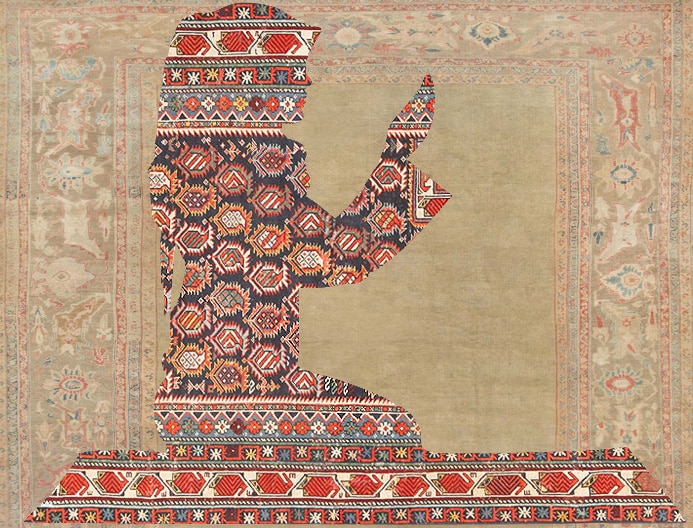
Muslim Prayer Rug
The introduction of Islam meant a new style of rug that is specifically designed for performing these prayers. These small size rugs that are easy to carry, have a design element known as the mihrab, or prayer niche. This type of carpet is used to represent the mosque. It has a base and minaret on top, similar to those found on the tops of mosques, where the call to prayer is issued. The top of the rug is placed towards Mecca for the recitation of the prayers. All practitioners are required to know the direction of Mecca, regardless of where they are in the world. These special carpets are an important part of the Islamic faith.

Mihrab Design in Islamic Muslim Antique Prayer Rugs
Islamic Mihrab design prayer carpets are highly ornate and have different designs that include florals, geometric, and sometimes, though very rarely, pictorial scenes. They are ornate just like the mosques that they are meant to represent. You will often recognize many elements of architecture in them, such as columns and arches. Once the prayers are said, the carpet is carefully rolled up and treated as a sacred object. This careful treatment of this special class of Islamic rugs means that we have more of them in existence from previous centuries than many other types of rugs.
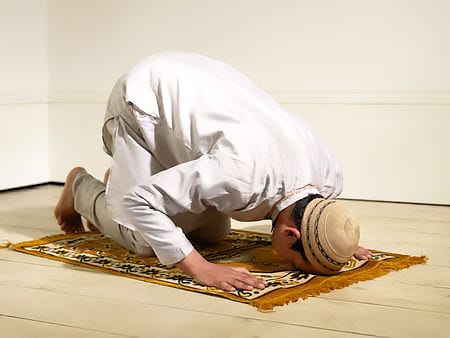
Muslim man praying on an Islamic prayer Rug
A New Islamic Artistic Philosophy
One of the differences between tribal rugs and Islamic Court rugs is the representation of symbols and patterns. Many times, in the tribal carpets produced according to ancient traditions, these motifs and symbols had a specific meaning that could be understood by the viewer. It is much like a primitive form of writing. However, in Islam, the motifs found in artwork do not typically have a specific meaning, but they do represent a certain philosophy.
One example of this is the use of tiled patterns in a carpet. They are meant to bring beauty and harmony into the world and reflect both the unity and diversity created by God. The symmetry reflects cosmic equilibrium and harmony. The carpet itself represents the impermanence of earthly objects in comparison to the higher order of the heavens.
Another practice that one will find in Islamic artwork is that when creating these tiled geometric shapes, there will be an intentional mistake. This “mistake” as an act of humility to indicate that nothing is perfect but God. Sometimes this mistake will be hidden, and other times, it will be quite obvious, depending on the preferences of the artist.
Representation of Plants and Animals
One of the tenants held by some of the more orthodox orders of Islam is a prohibition against making “graven” images. However, one can find many historical examples of carpets that depict plants, animals, and even people throughout areas that were under heavy Islamic influence at the time the carpet was produced. The adherence to practice depends on the attitude of the local ruler in accordance with these tenets. This brings up the point that the effects of Islam on art design were not evenly distributed and that local customs also played important roles.
Some artists used abstractions of plants, animals, and human forms as a way of adherence to this prohibition. In certain areas this was considered acceptable, and in others, even this was forbidden. However, this style gave rise to many new art forms and motifs. The influence of Islam was not uniform across all regions of the world throughout its 1400 years of history. However, one seldom finds depictions of plants or animals on objects meant to be used for religious purposes. Many of these figures are found in secular rather than religious art in the Islamic world.
The spread of Islam throughout the world meant changes in all areas of society. The degree of these changes was dependent upon the orthodoxy that was adopted by the local rulers. It is essential to understand that the introduction of Islam meant an expansion of the arts and the introduction of new tools and motifs. In many areas, this allowed the carpet weaving industry to move from a cottage industry to reach the status of fine art that it is today.
Patterns Within Islamic Art
Thousands of years ago, a new art form was created to express thoughts and feelings associated with Islam. This became the signature art form of a major religion, coming with it as it spread from country to country.
Islamic art is found in all throughout the Middle East, Egypt, Morocco, and Spain. This unique art has a rich history and reflects the culture of Islam. It is used in both religious and non-religious settings. Islamic art features vibrant and complex patterns that convey sophistication and symmetry. Most importantly, all of these different patterns are symbolic. Within these patterns we find shapes like stars, flowers, hexagons, and abstract shapes interacting with each other within intricate borders. Whether found on rugs, tapestries, curtains, wallpapers, book covers, or anywhere else, it stands out as a style unlike any other.
Within Islam, there are many restrictions on actions in every area of life. This includes restrictions on what Islamic artists can create and/or display. There is a concept called aniconism, which is basically the absence of material representations of humans and animals. Understanding and abiding by this concept is thought to prevent people from worshiping an image instead of worshiping God. Secular Islamic art sometimes includes humans and animals, but traditional Islamic art rarely does.
Islamic art is often found directly on a wall, on a canvas hanging on a wall, or as a ceramic. These are intricate and colorful, with a mix of geometric shapes and abstract shapes. The beauty of Islamic art is not solely held in its appearance, but in its way of serving as a symbol for ideas and concepts that are valued in Islamic culture. Let’s explore some key characteristics of Islamic art, what influenced those characteristics, and some specific types of Islamic artwork.
Motifs are decorative designs or patterns. Floral motifs, geometric motifs, and calligraphy are the three key characteristics of this art form. Each of which is influenced by material found in the Koran (Qur’an).
Floral Designs in Islamic Art
In Islamic art, floral designs are used instead of humans and animals because floral designs symbolize growth and life. Floral designs can convey ideas about human life better than some people think they can. While certain types of flowers and plants have known religious meanings within Islam (such as cypress trees, which often represent humility before God), the ones that do not can be used in Islamic art in ways that impart knowledge of principles found within the Koran.
Timurid manuscripts, Ottoman tiles, and Safavid carpets often feature Islamic art. In the case of those three categories, the floral patterns will have flowers with four or five petals. Also the works of art featured on those items will also have floral patterns that interlacing, rhythmic, and/or scrolling. Interlacing is also called arabesque, this is when the shapes in the artwork look as though they are loosely or closely holding onto each other. Rhythm is created in visual art by the repetition of shapes and lines. It is easier to create a rhythmic pattern with geometric shapes than with flowers and plants. Scrolling refers to vines or curved lines that are placed in the artwork appearing tangled and/or continuous. To master the creation of these designs, artists utilize techniques such as grids while also creating some of the designs completely freehand. With much practice, making the designs neat and symmetrical is achieved.
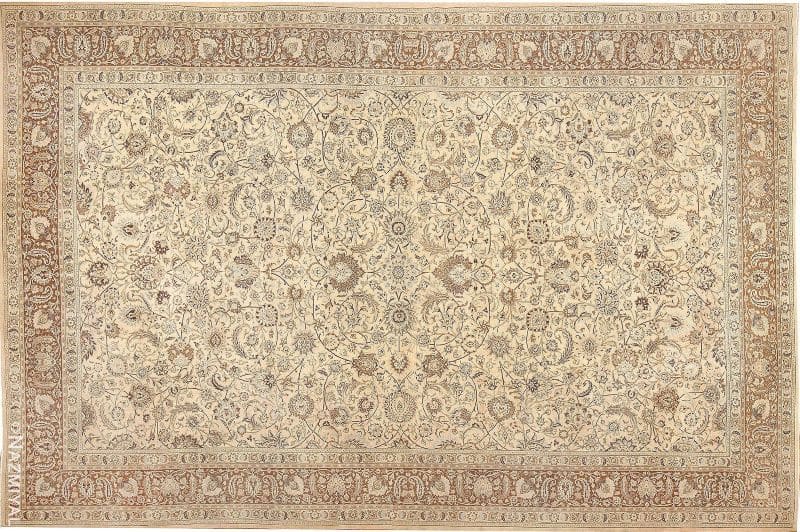
This Khorassan rug features an arabesque (aka Islimi) design.
Geometric Patterns in Islamic Art
Geometry in Islamic art involves a variety of different shapes that form patterns to reflect the language of the universe. Metal, paper, wood, glass, carpet, ceramics, and jewelry are just a few of the mediums where geometric patterns are commonly found. Geometric patterns often overlap with or form the framework for floral designs and calligraphy.
The 9th century marks the beginning of the use of stars in geometric patterns in Islamic art. Stars with 6 points and ones with 13 points emerged in patterns the 13th century. As time went on, Islamic artists continued to improve their techniques and use stars with even more points.
Geometric designs focus on shapes and non-living objects.The complexities of geometric designs encourage viewers to examine them more closely and think about their meanings. These designs are described as looping and scrolling because in art, lines and shapes convey motion. Upon looking at this kind of design, the viewers eyes almost naturally move around the artwork following the implied motion of the objects in it. Like other types of art, every viewer will have their own take on the meaning of the design. It is interesting to see how different people perceive geometric designs.
Calligraphy in Islamic Art
Calligraphy is one of the key characteristics of Islamic art, and is said to be a way of celebrating and remembering God. Verses from the Koran are written into pieces of artwork in an expressive, harmonious, and rhythmic way. These are commonly found on ceramics, metalwork, mosque walls, school walls, and the walls of many other buildings in Islamic countries. These verses are usually written in Arabic, Persian, or Turkish.

Calligraphy is present in many forms of Islamic art.
Traditional Islamic art involving calligraphy is created with two different types of pens. One of the pens is called a galam and it is made completely of natural wood. The other pen has a metallic tip. The mediums for this calligraphy are usually paper, tiles, vessels, carpets, or stone.
Why do Muslims tend to have many more rugs than other cultures?
The observation that Muslims may have more rugs than some other cultures can be attributed to a combination of cultural, religious, and practical factors. It’s important to note that this is a generalization and may not apply universally to all Muslims or all cultures within the Islamic world.
Here are some reasons why rugs tend to be more prevalent in Muslim households:
- Prayer Rituals (Salah): Muslims are required to perform five daily prayers, and having a dedicated space for prayer is important. Rugs are often used to create a clean and comfortable area for prayer, especially when praying on a hard or cold surface. Many Muslim households have prayer rugs to facilitate this religious practice.
- Cultural Traditions: Rugs have been an integral part of the cultural traditions in many Islamic societies for centuries. Different regions have distinct rug-making traditions, and the use of rugs in daily life is deeply embedded in the cultural heritage of these societies.
- Artistic Expression: Islamic art often incorporates intricate patterns, arabesques, and vibrant colors. Rugs are considered a form of artistic expression, and the appreciation for the craftsmanship and aesthetic appeal of rugs has led to their widespread use in Muslim households.
- Symbolism and Spirituality: Rugs often feature symbols, motifs, and calligraphy with religious significance. These elements add a spiritual dimension to the living space and serve as a visual reminder of Islamic teachings. Arabic calligraphy and Quranic verses may be woven into rug designs.
- Climatic Considerations: In some Muslim-majority regions, where the climate can be hot and dry, rugs provide a softer and more comfortable surface than hard floors. Rugs also contribute to insulation and warmth during colder seasons.
- Hospitality Practices: Offering a clean and comfortable rug to guests is a common practice in many Muslim cultures. Rugs are used to create inviting and welcoming spaces for social gatherings and hospitality.
- Economic Factors: The rug-making industry is often a significant economic activity in some Muslim-majority countries. Local artisans and weavers contribute to the economy through the production and sale of rugs. This economic factor can lead to a higher prevalence of rugs in households.
- Cultural Significance of Carpets: Carpets and rugs have historically been highly valued commodities in various Islamic societies. They have been traded, gifted, and passed down through generations, contributing to their cultural significance.
It’s essential to recognize that the use of rugs in Muslim households varies based on individual preferences, regional traditions, and economic factors. While some households may have a large number of rugs, others may have fewer. The prevalence of rugs in Islamic cultures is rooted in a combination of cultural practices, religious traditions, and the aesthetic appeal of these textiles.
This rug blog about the advent of the Islamic Art and Islamic carpets was published by Nazmiyal Antique Rug Gallery in NYC.

